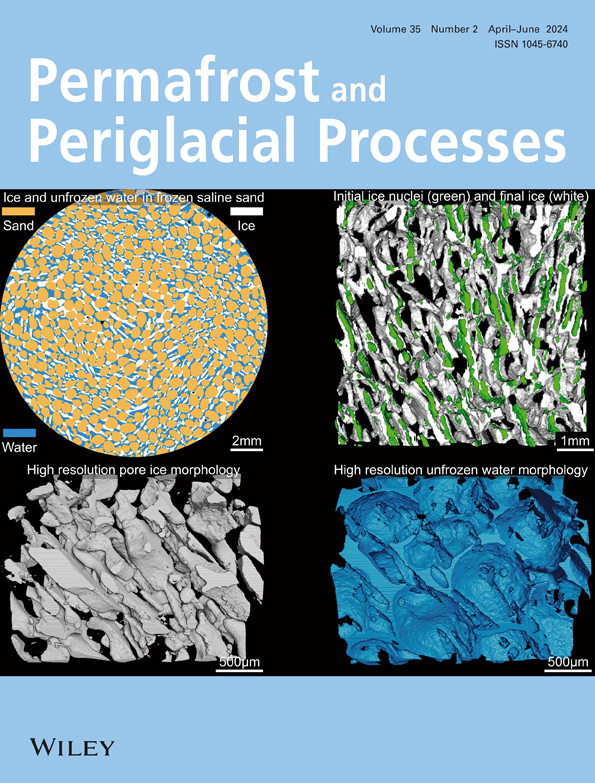雅库特中部冰楔中CO2、CH4和N2O的来源及其关系
IF 3.3
3区 地球科学
Q2 GEOGRAPHY, PHYSICAL
引用次数: 0
摘要
全球变暖导致的冻土融化将促进完整有机碳和氮的生物再矿化,并将温室气体(GHG)释放到大气中,这将对未来的全球变暖产生正反馈。然而,温室气体预算及其在永久冻土中的控制尚不完全清楚。本研究旨在利用新的气体和化学数据,更好地了解地面冰中温室气体的控制机制。在这项研究中,我们提供了位于西伯利亚雅库特中部的Churapcha、sydakh和Cyuie三个不同冰楔中二氧化碳(CO2)、甲烷(CH4)和一氧化二氮(N2O)混合比例的新数据。研究冰楔的温室气体混合比为CO2 0.0% ~ 13.8%, CH4 1.3 ~ 91.2 ppm, N2O 0 ~ 1414。特别地,所有三个冰楔都表明富含CH4的冰楔样品在N2O混合比中被耗尽,反之亦然。N2-O2-Ar组成表明,冰楔极有可能是由干雪或白霜形成的,而不是由雪融水冻结形成的,并且O2消耗生物代谢活跃。大多数观测到的温室气体混合比不能用微生物代谢来解释。硝酸盐(包括N2O)的反硝化产物的抑制作用可能是控制冰楔CH4混合比的重要因素。本文章由计算机程序翻译,如有差异,请以英文原文为准。
Origin of CO2, CH4, and N2O trapped in ice wedges in central Yakutia and their relationship
Permafrost thawing as a result of global warming is expected to foster the biological remineralization of intact organic carbon and nitrogen and release greenhouse gas (GHG) into the atmosphere, which will have positive feedback for future global warming. However, GHG budgets and their controls in permafrost ground ice are not yet fully understood. This study aims to better understand the control mechanisms of GHG in ground ice by using new gas and chemistry data. In this study, we present new data on carbon dioxide (CO2), methane (CH4), and nitrous oxide (N2O) mixing ratios in three different ice wedges, Churapcha, Syrdakh, and Cyuie, located in central Yakutia, Siberia. The GHG mixing ratios in the studied ice wedges range from 0.0% to 13.8% CO2, 1.3–91.2 ppm CH4, and 0% and 0–1414 N2O. In particular, all three ice wedges demonstrate that ice‐wedge samples enriched in CH4 were depleted in N2O mixing ratios and vice versa. N2–O2–Ar compositions indicate that the studied ice wedges were most likely formed by dry snow or hoarfrost, not by freezing of snow meltwater, and the O2‐consuming biological metabolism was active. Most of the observed GHG mixing ratios cannot be explained without microbial metabolism. The inhibitory impact of denitrification products of nitrate (including N2O) could be an important control of the ice‐wedge CH4 mixing ratio.
求助全文
通过发布文献求助,成功后即可免费获取论文全文。
去求助
来源期刊
CiteScore
9.70
自引率
8.00%
发文量
43
审稿时长
>12 weeks
期刊介绍:
Permafrost and Periglacial Processes is an international journal dedicated to the rapid publication of scientific and technical papers concerned with earth surface cryogenic processes, landforms and sediments present in a variety of (Sub) Arctic, Antarctic and High Mountain environments. It provides an efficient vehicle of communication amongst those with an interest in the cold, non-glacial geosciences. The focus is on (1) original research based on geomorphological, hydrological, sedimentological, geotechnical and engineering aspects of these areas and (2) original research carried out upon relict features where the objective has been to reconstruct the nature of the processes and/or palaeoenvironments which gave rise to these features, as opposed to purely stratigraphical considerations. The journal also publishes short communications, reviews, discussions and book reviews. The high scientific standard, interdisciplinary character and worldwide representation of PPP are maintained by regional editorial support and a rigorous refereeing system.

 求助内容:
求助内容: 应助结果提醒方式:
应助结果提醒方式:


